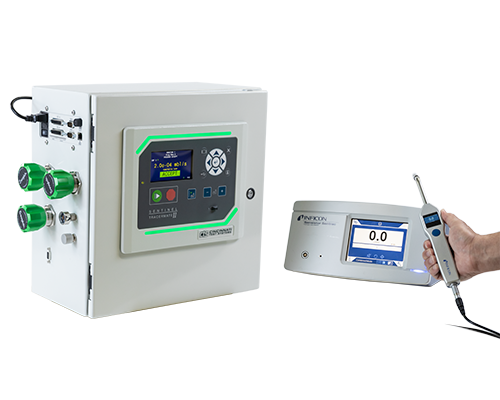Sniff Leak Testing
Atmospheric Sniff Leak Testing, or a sniffer test, is a basic method of tracer gas leak detection that uses a sniffer probe to detect the presence of tracer gas and pinpoint an area that is leaking. During the sniff test process, a part or component is evacuated, and then filled with a tracer gas such as hydrogen. A probe is then manually moved over the surface of the part to detect leakage. Sniff leak testing is highly effective at sensing and locating micro leaks and is best suited for operator dependent assembly, test, and rebuild processes.
Highlights of Sniffer Leak Testing:
- Low cost tracer gas testing method that pinpoints the location of the leak
- Can detect leaks in the range of 1.6 x 10-1 to 1x10-5 scc/s
- Works best in an environment that is well ventilated, free of trace-gas
- Effectiveness is limited in environments where background noise (air flow) reduces the measurable concentration of the gas tracer
- Since sniff leak detectors are typically operated manually, the reliability of the sniff test is dependent upon the experience of the operator.
The sniffer test method is relatively economical depending on the type of tracer gas used and, when used properly, is a reliable solution for leak location and detection.
Contact us today to learn more about our sniff leak detectors.

Sniffer tests are useful for leak location such as:
- Testing subassembly joints and part connections
- Testing final assemblies, including connection points
- Testing assemblies in a rebuild station (locate and fix a leak, then retest)
Sniffer Leak Detector Technology for Fast and Reliable Testing
Our sniff system includes a CTS TracerMate hydrogen gas sniffer leak detector system, a hand-held probe and an Inficon or other brand mass spectrometer.
To conduct a sniffer test, a part is filled with tracer gas and the hand-held probe is then moved close to the area being checked for leakage. The sniffer probe draws in the air sample from around the part test area and into the mass spectrometer, where it is analyzed for tracer gas concentration. When the mass spectrometer detects a tracer gas concentration that exceeds the leak rate setpoint previously set in the TracerMate, it signals the TracerMate and the part fails the leak test.
The TracerMate atmospheric sniff system can be programmed to perform up to 20 sequential tests, each one started separately, and saved as a multi-point leak test as one test record. It operates using a hydrogen/nitrogen gas mix and features a simple “plug and play” interface connection for easy setup.
Contact Us for a Custom Sniff Leak Testing System today
We can provide custom sniff systems designed to provide automated 'hands-free' sniff leak testing for single or multiple locations using one test program. The system shown here provides a custom fixture to position the sniffer probe and circuitry to perform progressive leak testing at multiple locations using one-part setup.